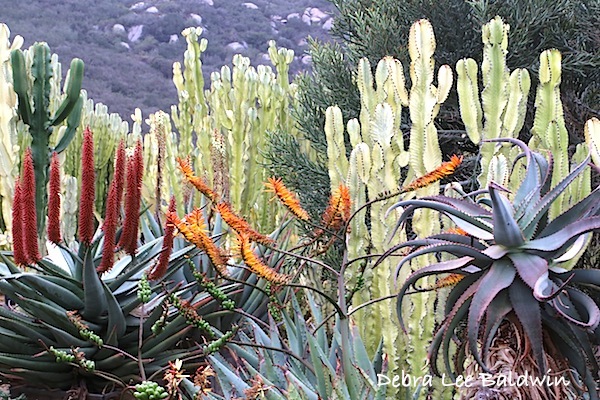 There’s a nursery near my home aptly named Desert Theater. It’s nine acres of big, bold, dramatic, over-the-top succulents and cacti. It’s one of the nurseries I enjoy taking people to, because they’re invariably amazed.
There’s a nursery near my home aptly named Desert Theater. It’s nine acres of big, bold, dramatic, over-the-top succulents and cacti. It’s one of the nurseries I enjoy taking people to, because they’re invariably amazed. 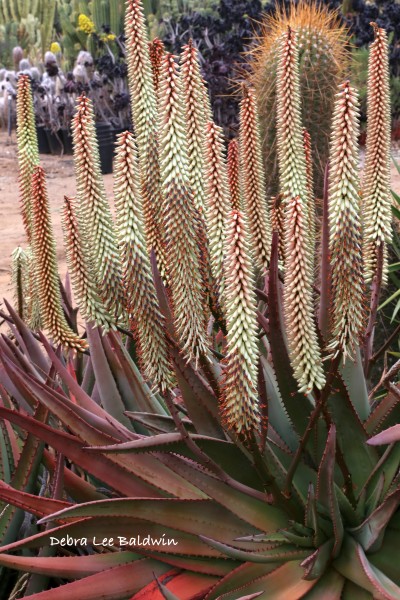 It’s a photographer’s feast any day of the year, but my favorite time to go is mid-winter when large aloes come into bloom. Aloes are native to parts of Africa that have a similar climate to Southern California’s.
It’s a photographer’s feast any day of the year, but my favorite time to go is mid-winter when large aloes come into bloom. Aloes are native to parts of Africa that have a similar climate to Southern California’s. 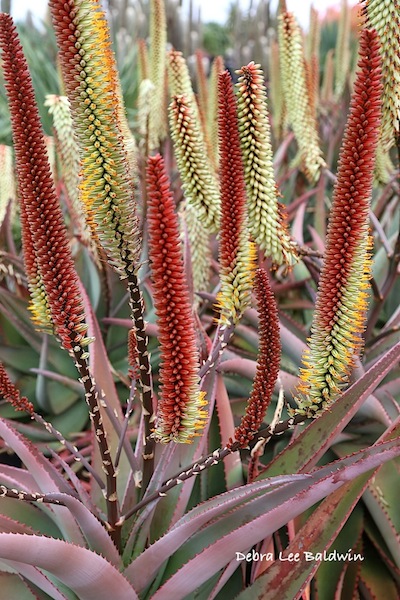 Owner Brandon Bullard is a plant wizard, but he has yet to give these hybrids names. I suspect most have in their lineage Aloe ferox, Aloe marlothii, Aloe africana, Aloe speciosa and/or Aloe castanea.
Owner Brandon Bullard is a plant wizard, but he has yet to give these hybrids names. I suspect most have in their lineage Aloe ferox, Aloe marlothii, Aloe africana, Aloe speciosa and/or Aloe castanea. 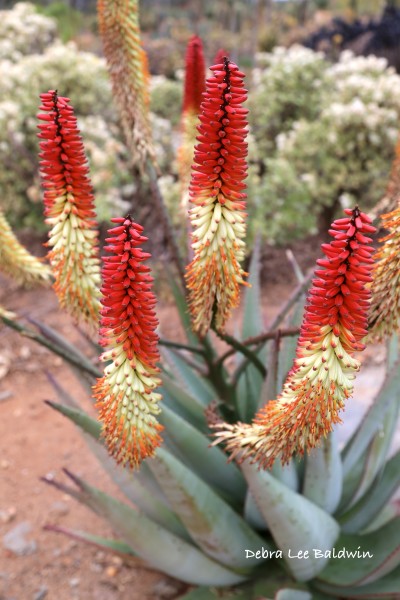 This double-colored, cream and rose flower is typical of Aloe speciosa…except this one has shorter stems and the flowers that line the bloom spike are not as tightly packed. And the flower heads aren’t tilted, which also is characteristic of the species.
This double-colored, cream and rose flower is typical of Aloe speciosa…except this one has shorter stems and the flowers that line the bloom spike are not as tightly packed. And the flower heads aren’t tilted, which also is characteristic of the species.  And these look sort of like Aloe africana. They’re the right color, but Aloe africana flower spikes are pointed, and the lower part frills outward like a skirt.
And these look sort of like Aloe africana. They’re the right color, but Aloe africana flower spikes are pointed, and the lower part frills outward like a skirt. 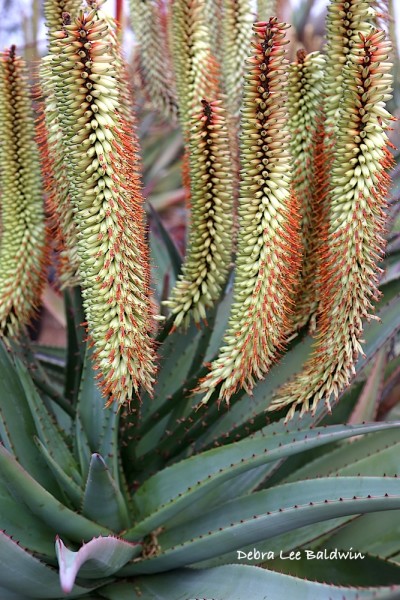 The plant and the shape of the flower spikes suggest Aloe ferox, but the flowers are the wrong color. Aloe ferox flowers are rose-red to shades of orange. I wonder what contributed the cream?
The plant and the shape of the flower spikes suggest Aloe ferox, but the flowers are the wrong color. Aloe ferox flowers are rose-red to shades of orange. I wonder what contributed the cream? 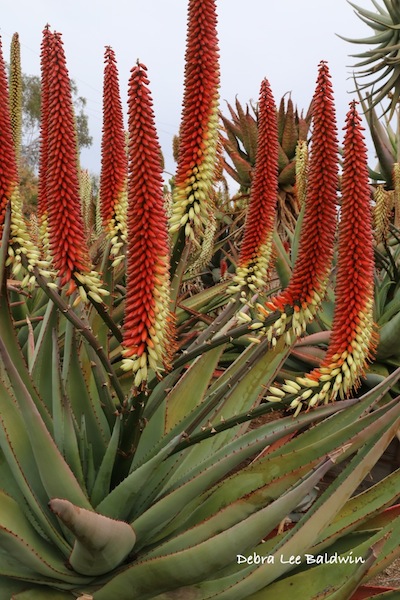 Again, a guess: Aloe ferox x Aloe speciosa?
Again, a guess: Aloe ferox x Aloe speciosa? 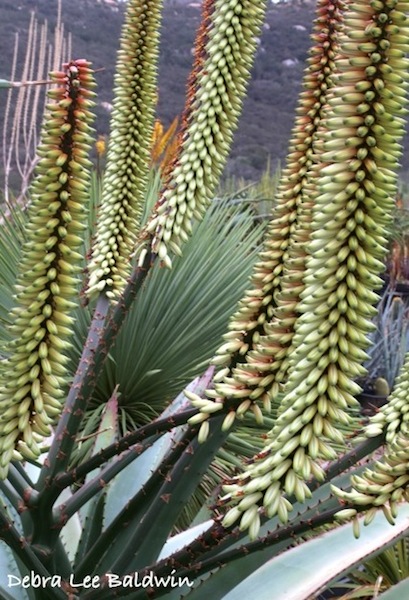 And pale green flowers tinged with orange? I have no idea!
And pale green flowers tinged with orange? I have no idea! 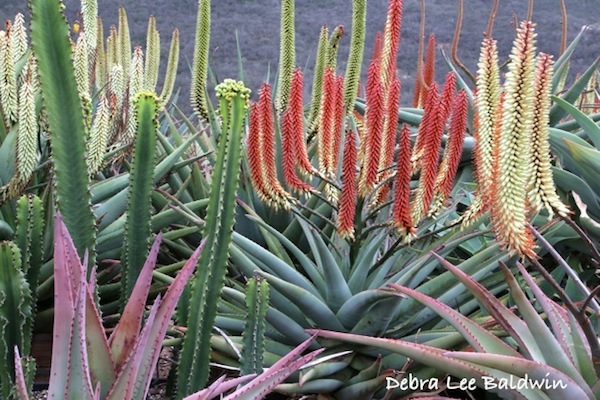 Another mystery medley, with some euphorbias on the left. Don’t you love the violet leaves in the foreground?
Another mystery medley, with some euphorbias on the left. Don’t you love the violet leaves in the foreground? 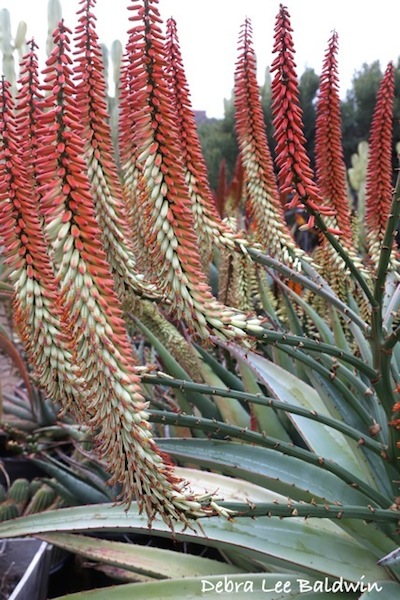 I vote for naming this one Aloe ‘Peaches and Cream’.
I vote for naming this one Aloe ‘Peaches and Cream’. 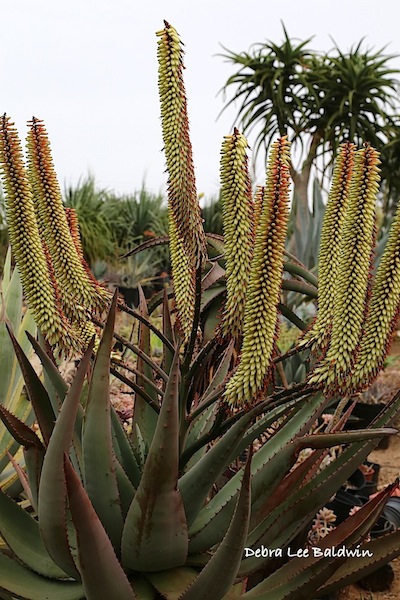 And what about this one? Aloe ‘Corncob’? My goal is to share the beauty of waterwise, easy-care succulents in gardens, containers and landscapes via blog posts, newsletters, public speaking and workshops, photos, videos, merchandise, and social media (Facebook and Pinterest). My books: Designing with Succulents, Succulent Container Gardens, and Succulents Simplified. www.debraleebaldwin.com
And what about this one? Aloe ‘Corncob’? My goal is to share the beauty of waterwise, easy-care succulents in gardens, containers and landscapes via blog posts, newsletters, public speaking and workshops, photos, videos, merchandise, and social media (Facebook and Pinterest). My books: Designing with Succulents, Succulent Container Gardens, and Succulents Simplified. www.debraleebaldwin.com
More Amazing Aloes: South Africa in San Diego
– Posted in: SucculentsStunning photographs
My goodness, talk about “bombs bursting in air”… looks like 4th of July fireworks in mid winter. These are very exciting to get to see.
My opinion is the poetry of succulents comes from the fact they take almost obvious and simple geometrical-mathematical forms. And simple, geometrically and fractally speaking is also complex, of course, the duality simple-complex of life. The duality simple-complex of beauty.
Gorgeous pics! The reason I don’t care to use aloes in my yard any more though, is the brutally sharp points and “thorns”. Weeding around them is a nightmare.
Looks like I need to put Desert Theatre on my bucket list! Have I already told you that I love your new book ” …Simplified?” I am constantly referring to it.
This is so timely….I’ve been struggling to I.D, a succulent for several yrs and just posted a pic of it on (in bloom) on my blog yesterday. I know you’re an expert in aloe, so if you don’t mind taking a look, maybe you could tell me what it is?
If you click the link I left in the “website” field above it will bring you to my blog’s most recent post which includes the plant in question.
Let me know!
Great photos Debra! There’s been a lot of aloe hybrid breeding in South Africa by Leo Thamm of Sunbird Aloes in Johannesburg which has produced many similar-looking plants to these. I love aloes, as here in ‘cool’ subtropical Sydney, some start flowering in early autumn (like ‘Baby Yellow’ – a fab ground clumping form with spikes of lemon-yellow flowers), the peak is in winter when not much else is going on, and others are still flowering in mid spring.
Wow…fascinating…and I love the name…I titled my certified habitats “Desert Dominion,” Desert Theatre tops all…truly apropos….beautiful; thanks for the Post ! 🙂
Wow! Amazing in bloom. Wish we could grow here in northern VA. Hesperaloe parviflora (a relative) you see in gardens here and a couple other marginally hardy. Or in pots. But this winter they could be mush. Too much winter wet — i.e., snow.
